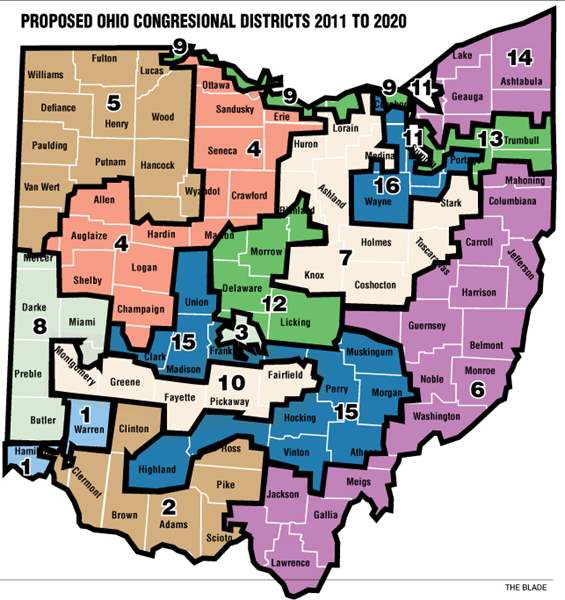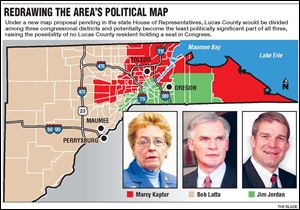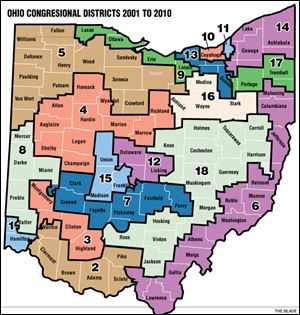
Kaptur's district reshuffled
Latta to get Sylvania; Jordan takes downtown Toledo
9/14/2011
Ohio Congressional Districts 2011-2020

Redrawing the area's political map.
Toledo and Lucas County would be divided into three congressional districts under a new map unveiled by Ohio House Republicans Tuesday and on a fast-track to passage.
The 9th Congressional District, represented by U.S. Rep. Marcy Kaptur (D., Toledo), would lose big parts of its Lucas County base and turn into a narrow string of communities extending to Cleveland -- potentially setting up a primary battle between Miss Kaptur and Rep. Dennis Kucinich (D., Cleveland).
U.S. Rep. Bob Latta (R., Bowling Green) would take over all of western Lucas County and parts of West and South Toledo.
U.S. Rep. Jim Jordan (R., Urbana) would have to learn his way around downtown Toledo, which would become part of his sprawling district, along with the south end, north end, most of East Toledo, most of Oregon, and part of Jerusalem Township.
The bill was introduced Tuesday and discussed at a hearing of the House State Government and Elections Committee.
Miss Kaptur blasted the GOP-drawn lines as designed to protect GOP incumbents at the expense of Lucas County.
"Their map achieved one thing -- Republican incumbent protection statewide. For the first time since the Civil War, a Toledo-centered congressional district has been eliminated by the Republican Party. Since the Civil War, we [Toledo] have been at the center of a district. The most populous city in northwest Ohio has now been hacked up," Miss Kaptur said.
Noting how her district follows the Lake Erie shoreline through Lucas, Ottawa, Erie, Lorain, and Cuyahoga counties, split into two pieces by Sandusky Bay, she joked, "I'm looking at used boats right now."
She said other communities in the district, all the way to Cleveland, have been "hacked up" as well.
"What a tragedy for communities in northern Ohio hurting in this economy," Miss Kaptur said.
She noted that the state tends to vote 50-50 in presidential contests, which is why Ohio is one of a handful of "battleground" states. However, the districts are drawn to produce three Republicans for every Democrat.
Mr. Latta's 5th District, which now stretches more than halfway across the state, would become more compact. If approved, it will contain, in addition to part of Lucas County, all of Wood, Hancock, Fulton, Henry, Williams, Defiance, Paulding, Van Wert, and Putnam counties, and parts of Wyandot, Hardin, and Mercer counties.
Mr. Latta currently represents the southwest corner of Lucas County. He would take over the rest of western Lucas County, as well as Ottawa Hills, Sylvania, Sylvania Township, Springfield Township, West Toledo as far as Jackman Road, Maumee, and much of South Toledo.
Mr. Jordan's district surrenders Hancock County to Mr. Latta, but will include Seneca and Sandusky counties and part of Ottawa County for the first time. In addition to part of Lucas County, the 4th District also would include all of Allen, Auglaize, Crawford, Logan, Shelby, and Champaign counties, and parts of Erie, Wyandot, Huron, Hardin, Marion, Mercer, and Clark counties.
In Lucas County, Mr. Jordan would represent most of Oregon, part of Jerusalem Township, East Toledo, downtown Toledo, and parts of North and South Toledo.
Mr. Latta and Mr. Jordan could not be reached for comment.
No political price

Ohio Congressional Districts 2001-2010
Mr. Jordan has emerged as a leader of the Tea Party faction in the U.S. House and headed a group that opposed House Speaker John Boehner (R., Ohio) on the recent deal to raise the national debt. Speculation that Mr. Jordan would pay a political price for opposing Mr. Boehner has proved to be unfounded.
Steve Fought, a spokesman for Miss Kaptur, said the addition of Democrat-rich precincts in Toledo to Mr. Jordan's portfolio won't hurt him much.
"They can afford to give Jordan East Toledo because the rest of the district is so Republican," Mr. Fought said.
Likewise, the Democratic precincts in Toledo that will become part of Mr. Latta's 5th District -- such as Old Orchard -- will be heavily offset by Republican votes elsewhere.
Some critics said the new districts are designed with one goal in mind: creating 12 incumbent Republican districts and squeezing Democrats into the remaining four districts.
Michael Beazley, a longtime Democratic Party leader in Lucas County and currently the administrator of Oregon, said Lucas County is cut up in such a way that it could wind up as the least significant part of all three districts, rather than as the focal point of one congressional district as it is now.
"It certainly looks like a map that is drawn with the intent to reduce the opportunity for a strong voice for Lucas County," Mr. Beazley said.
"There are times when it serves the interests of the community to have more than one congressman, but when you become a very small part of the district you lose the statistical significance to be an important part of the district to the representative. That's a potential problem for the county. It certainly looks like that's what's happening here," he said.
'Gerrymandered map'
"Visually it looks like it is a gerrymandered map," said Ann Henkener, a redistricting specialist with the League of Women Voters of Ohio. "If indeed it is true that it is drawn to have four Democratic and 12 Republican districts, I would call that a gerrymandered map."
"What they've done to Toledo I think is pretty bad. First of all, it's been split up and I would really like to see the metropolitan areas stick together. Lucas County is pretty split up and probably it wasn't necessary to do that. Kaptur's district was a little strange before. The 'community of interest' between Toledo and Cleveland is, I think, a little tenuous."
Daniel P. Tokaji, a law professor specializing in election law at Ohio State University, said, "This proposed plan has all the earmarks of the partisan gerrymander, and I would be shocked if it were not challenged."
The redrawing of congressional districts occurs every decade, following the U.S. Census. Ohio's sluggish population growth between 2000 and 2010 -- the fourth-slowest in the country -- meant that it must give up two of its current 18 congressional seats. The redrawing of Congressional districts nationwide is continuing the long-term shift of political power to the South and West.
Hearings held

Ohio Congressional Districts 2011-2020
"This is a fair and legal map that incorporates input from Ohioans across the state," said state Rep. Matt Huffman (R., Lima), who chairs the Republican-controlled House State Government and Elections Committee.
"We held five regional hearings across Ohio and heard testimony from many witnesses who provided input on what the new congressional map should look like. Based on the public input at these hearings, I am confident that the map I am presenting today accomplishes several goals, among them creating fair and competitive districts," Mr. Huffman said.
He said the new boundaries of the 9th District meet the constitutional tests of population, communities of interest, and minority voting rights.
"The lakefront district looks like the same kind of district that it was before. In that sense it keeps together some core part of the district," Mr. Huffman said.
"I'm concerned about the length of that [9th] District,'' said Rep. Matt Szollosi (D., Oregon), the second highest-ranking Democrat in the House.
"I understand, with the reduction of two congressional districts, that we're going to see significantly more population in the remaining 16 districts,'' he said. "I prefer to see the district more condensed and based on fairness, as opposed to political concerns. Positioning Kaptur and Kucinich against each other is clearly politically motivated.''
Counties defended
State Rep. Teresa Fedor (D., Toledo), a member of the House State Government and Elections Committee, questioned whether the districts truly represent "communities of interest."
"The counties need to be preserved. You've got politicians selecting voters instead of voters selecting politicians. When you have a county piecemealed apart, those counties are almost powerless to affect any change," Ms. Fedor said. "It leaves Lucas County diminished at many different levels."
The 9th District has often been cited by critics of the current redistricting process as one that fares poorly in meeting the goals of having districts as geographically compact and contiguous as possible.
"When we do compactness measures, it scores exceedingly low,'' said Jim Slagle, of the Ohio Campaign for Accountable Redistricting. "It's hard to believe the 9th District would be drawn the way it is if Kaptur and Kucinich didn't live where they do.''
Mr. Kucinich welcomed the new map Tuesday. Until this week, he had been exploring the possibility of moving to Seattle and running for a congressional seat there.
Another chance
"It is an amazing turn of events that the legislature decided not to dismantle the district I represent. I have been praying that I could continue to serve my Cleveland-area constituency and it looks like I have a chance," Mr. Kucinich said. "That is all I could have hoped for."
Political experts will study the new political lines to determine which of the two "K" congressmen -- Miss Kaptur or Mr. Kucinich -- holds the upper hand politically.
Miss Kaptur would be expected to win in the part of the district in Lucas, Ottawa, and Erie counties, where she has been the representative for a decade. However, she will have to compete in two heavily populated areas that she does not now represent: the northern part of Lorain County that is currently part of the 13th District, represented by Democrat Betty Sutton, and western Cuyahoga and West Cleveland that Mr. Kucinich now represents.
"It places two friends in [a] district that each have tended to represent [in] their own sections of the state," Miss Kaptur said. She said she met Tuesday with Mr. Kucinich but didn't know what his political plans are. She said she definitely plans to run for re-election.
The full state House is slated to vote on the new districts Thursday, followed by a vote in the Senate, which is also controlled by Republicans, next week.
Analyses of the 2008 presidential vote showed distinct political leanings in all three proposed northwest Ohio districts. Voters in what will be the new 9th District went for Democrat Barack Obama by 65 percent, while Mr. Obama got 47 percent of the votes in the new 5th District and 44 percent of the votes in the new 4th District.
The map sacrifices one of the current 13 Republican districts in order to create a minority opportunity district in Franklin County. The map also makes several suburban Columbus GOP congressmen feel more secure by congregating many Franklin County Democrats into the new city-based district that would be considered safe for a Democrat.
Elements of the 7th District held by U.S. Rep. Steve Austria (R., Beavercreek) and the 3rd District held by U.S. Rep. Mike Turner (R., Dayton) would be combined, setting up a potential primary contest between them.
To offset the Democratic gain in Columbus, two northeast congressmen -- Ms. Sutton, an Akron-area Democrat, and U.S. Rep. Jim Renacci, a Wadsworth Republican -- would be put together in a district that on paper would favor the Republican.
Columbus Bureau Chief Jim Provance contributed to this report.
Contact Tom Troy at tomtroy@theblade.com or 419-724-6058.